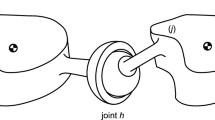Abstract
This paper presents an ellipsoidal set-membership uncertainty model for wire-based tracking systems with wire length uncertainties and joint clearances. Although the proposed model is valid for any number of wires and configurations, including singularities, it has been particularized to a 3-2-1 parallel wire mechanism. The Euler’s tetrahedron formula has been used to obtain a numerically stable solution to the direct kinematics of this particular tracking system as well as a compact characterization of its singularities directly expressed in terms of the wire lengths. It is also shown that these singularities, when expressed in the configuration space of the moving element, can be identified as C-surfaces associated with the three basic contacts between polyhedra, which have been widely studied in the context of path planning.
Access this chapter
Tax calculation will be finalised at checkout
Purchases are for personal use only
Preview
Unable to display preview. Download preview PDF.
Similar content being viewed by others
References
Avnaim, F., Boissonnat, J.D., and Faverjon, B. (1988), A practial motion planning algorithm for polygonal objects amisdst polygonal obstacles, Proc. of the IEEE Int. Conf. on Robotics and Automation, pp. 1656–1661.
Ceccarelli, M., Avila-Carrasco, C., and Ottaviano, E. (2000), Error analysis and experimental tests of CATRASYS (Cassino Tracking System), 2000 Int. Conf. on Industrial Electronics, Control and Instrumentation, IECON 2000, paper SPC11-SP2–4, Nagoya.
Ceccarelli, M., Toti, M.E., and Ottaviano, E. (1999), CATRASYS (Cassino Tracking System): A new measuring system for workspace evaluation of robots, Proc. of the 8th Int. Workshop on Robotics in Alpe-Adria-Danube Region RAAD’99, pp. 19–24, Munich.
Donald, B.R. (1984), Local and Global Techniques for Motion Planning, Master Science Thesis, MIT, Boston, Massachusetts.
Dörrie, H. (1965), 100 Great Problems of Elementary Mathematics. Their History and Solution, Dover Publications, New York.
Geng, Z., and Haynes, L.S. (1994), A 3–2–1 kinematic configuration of a Stewart platform and its application to six degree of freedom pose measurements, Robotics and Computer–Integrated Manufacturing, Vol. 11, No. 1, pp. 23 – 34.
Hightower, J., and Borriello, G. (2001), A survey and taxonomy of location systems for ubiquitous computing, UW CSE–01–08–0S, University of Washington, Department of Computer Science and Engineering.
Jeong, J.W., Kim, S.H., and Kwak, Y.K. (1999), Kinematics and workspace analysis of a parallel wire mechanism for measuring a robot pose, Mechanism and Machine Theory, Vol. 34, No. 6, pp. 825–841.
McCarthy, J.M. (2000), Geometric Design of Linkages, Springer-Verlag, New York. Peterson, M.A. (1997), The geometry of Piero della Francesca, The Mathematical Intelligencer, Vol. 19, No. 3, pp. 33–40.
Pottmann, H., and Wallner, J. (2001), Computational Line Geometry, Springer-Verlag, Berlin.
Ros, L., Sabater, A., and Thomas, F. (2002), An ellipsoidal calculus based on propagation and fusion, IEEE Trans. on Systems, Man and Cybernetics. Part B, Vol. 32, No. 4, to appear.
Tadokoro, S. at al. (1996), On the fundamental design of wire driven parallel manipulators with redundancy, In Japan/USA Symposium on Flexible Automation, pp. 151–158.
Thomas, F. (1995), An approach to the movers’ problem that combines oriented matroid theory and algebraic geometry, Proc. of the 1995 IEEE Int. Conf. on Robotics and Automation, Vol. III, pp. 2285–2293.
Zhu, J., and Ting, K-L. (2000), Uncertainty analysis of planar and spatial robots with joint clearances, Mechanism and Machine Theory, Vol. 35, pp. 1239–1256.
Author information
Authors and Affiliations
Editor information
Editors and Affiliations
Rights and permissions
Copyright information
© 2002 Springer Science+Business Media Dordrecht
About this chapter
Cite this chapter
Thomas, F., Ottaviano, E., Ros, L., Ceccarelli, M. (2002). Uncertainty Model and Singularities of 3-2-1 Wire-Based Tracking Systems. In: Lenarčič, J., Thomas, F. (eds) Advances in Robot Kinematics. Springer, Dordrecht. https://doi.org/10.1007/978-94-017-0657-5_12
Download citation
DOI: https://doi.org/10.1007/978-94-017-0657-5_12
Publisher Name: Springer, Dordrecht
Print ISBN: 978-90-481-6054-9
Online ISBN: 978-94-017-0657-5
eBook Packages: Springer Book Archive




